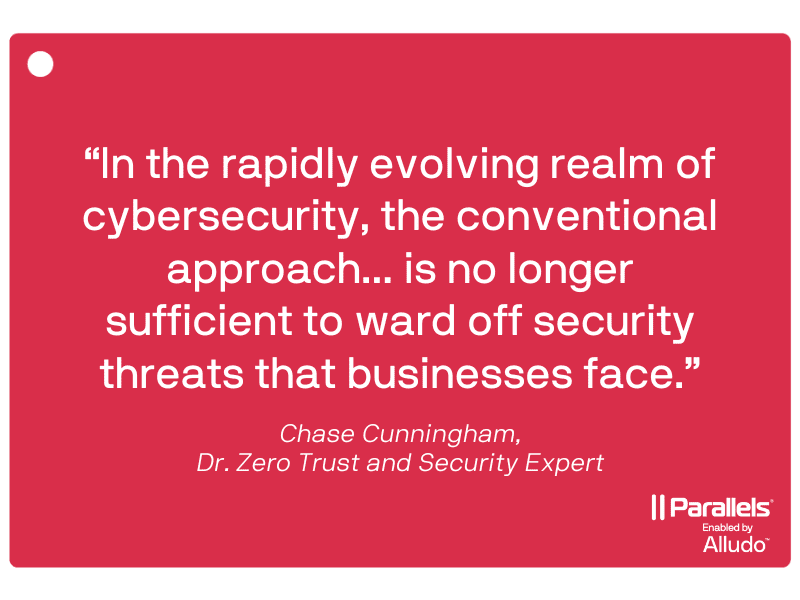
Beyond boundaries: How Remote Browser Isolation enables Zero Trust Security
In the rapidly evolving realm of cybersecurity, the conventional approach of relying on enterprise controls within the perimeter firewall is no longer sufficient to ward off security threats that businesses face.
There’s an urgent need for a more robust and adaptive security approach, particularly as work practices have been transformed and the traditional notion of a well-defined enterprise boundary has dissolved.
This is where the concept of “Zero Trust” comes into play.
Zero Trust challenges the traditional paradigm by assuming that no user or system should be inherently trusted, regardless of location within or outside the network.

A cornerstone of implementing Zero Trust effectively is the innovative solution known as Remote Browser Isolation (RBI).
Zero Trust addresses the limitations of traditional enterprise controls and extends protective measures beyond the typical boundaries. However, despite its value and utility, Zero Trust hasn’t necessarily been put into action yet. 59% of organizations say that they haven’t deployed a Zero Trust security architecture yet, as of 2022, according to an IBM report on the state of global security.
What’s more, as per a 2023 report via TripWire and Fortra, 31% of those surveyed said they were not yet ready or not sure where to start with Zero Trust.
Be one of the 60%+ who are prepared with Zero Trust by checking out what Parallels RAS and Awingu have to offer. Start your trial of Parallels Secure Workspace today!
The evolution of Zero Trust and its limitations
In an era where employees connect from various devices, networks, and locations, the concept of the traditional enterprise boundary has become obsolete.
This shift is driven by the rise of remote work, cloud services, and mobile computing.
In fact, 41.4% of IT leaders reported that they were increasing their use of cloud and 32.8% said they were migrating on-premises workloads to the cloud.
Thanks to the shift to the cloud (among other factors) the once-fortified perimeter has given way to a more fluid and permeable boundary, allowing data to traverse multiple networks and devices.
However, traditional enterprise controls, rooted in the firewall-centric approach, struggled to adapt to this dynamic landscape.
They were designed to counter external threats, assuming that adversaries would primarily target from outside the organization. They are perimeter barriers that cannot protect threats coming from inside the walls, but once that perimeter is breached malicious actors can exploit at will.
On the other hand, because Zero Trust architecture emphasizes continuous verification and only grants trust based on network location, threats can be contained even if the perimeter is breached.
This approach left a vulnerability gap, as it failed to address threats originating from within the network, which were often the result of compromised users or devices.
Zero Trust and Remote Browser Isolation (RBI) technology rise to the challenge
Zero Trust emerged as a response to these challenges.
Although the term was first used in 2010, Zero Trust as a concept didn’t begin to gain significant traction until around a decade later, when industry professionals and even the United States government introduced Zero Trust strategies.
Zero Trust shifts the security focus from a perimeter-centric model to a model that continuously verifies and monitors all user interactions, regardless of their location or origin.
This strategic approach emphasizes the importance of strong authentication, strict access controls, and least-privilege principles.
However, implementing Zero Trust requires a critical extension of security controls beyond the traditional enterprise boundary. This is where Remote Browser Isolation steps in as a pivotal component of Zero Trust.
RBI addresses the security gap that conventional controls were ill-equipped to cover—securing web interactions beyond the firewall. RBI functions by isolating web browsing sessions in a remote environment.
Users engage with web content through secure cloud-based containers, ensuring that any malicious elements remain quarantined from both the user’s local device and the internal network.
This proactive measure effectively mitigates the risk of web-borne threats infiltrating an organization’s infrastructure, even in scenarios where users inadvertently access malicious websites. Despite how Zero Trust addresses that security gap, only 10% of large enterprises will have a mature and measurable Zero Trust program by 2026.
Changing enterprise security budgets: the data behind the transformation
One noteworthy aspect of this paradigm shift is the change in enterprise security budgets.
Traditional security models often allocate substantial resources to fortifying the perimeter, investing in firewalls, intrusion detection systems, and other network-centric defenses.
However, as the enterprise boundary has expanded and the importance of securing interactions beyond the firewall has become evident, organizations are reallocating their budgets to support Zero Trust initiatives. And that strategy pays off, literally.
Companies that support Zero Trust realize 20.5% lower costs or a data breach than those not using Zero Trust. This shift reflects a strategic acknowledgment of the evolving threat landscape and the need for a more comprehensive security approach.
These investments not only enhance protection against web-based threats but also signify a commitment to fostering a culture of continuous verification and robust security across all touchpoints.
Zero Trust doesn’t exist in isolation, after all, rather it is an all-encompassing strategy, and building it into the organization’s overarching systems and processes is key towards enabling it effectively.
Embracing the future and taking a holistic approach to cybersecurity
In an interconnected world where remote work, cloud computing, and mobile devices are integral components of modern business operations. Embracing Zero Trust and technologies like Remote Browser Isolation is not a choice; it’s a necessity.
As cybersecurity threats continue to evolve, businesses must adapt their strategies to safeguard their data and digital assets effectively.
By implementing Zero Trust principles and leveraging solutions like RBI, organizations can navigate the intricacies of today’s threat landscape with confidence.
You know that your security measures transcend historical boundaries and are primed to adapt to whatever challenges lie ahead.
Start the journey towards a more secure future now with Parallels RAS and Awingu. Get your free trial of Parallels Secure Workspace now and see how your organization can enable Zero Trust with RBI.


